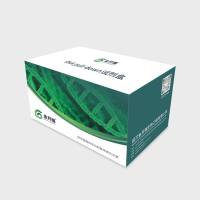Membrane‐Based Yeast Two‐Hybrid System to Detect Protein Interactions
互联网
- Abstract
- Table of Contents
- Materials
- Figures
- Literature Cited
Abstract
The classical yeast two?hybrid system and its modifications have been successfully used over the past decade to investigate interactions between most classes of proteins expressed in a given cell or tissue. However, some proteins (e.g., integral membrane proteins or nuclear proteins) are relatively difficult to investigate by standard yeast two?hybrid methods either because they are retained at cellular membranes or they activate the system in the absence of a true protein interaction. The membrane?based yeast two?hybrid (MbY2H) system presented in this unit overcomes some of these limitations. It is based on the split?ubiquitin protein complementation assay and detects protein interactions directly at the membrane, thereby allowing the use of full?length integral membrane proteins and membrane?associated proteins as baits to hunt for novel interaction partners. A simple modification also allows the use of proteins that are self?activating in a classical yeast two?hybrid system (e.g., acidic proteins and many transcription factors). Like the yeast two?hybrid system, the MbY2H system can also be used for interaction discovery by screening complex cDNA libraries for novel interaction partners. Curr. Protoc. Protein Sci. 52:19.7.1?19.7.28. © 2008 by John Wiley & Sons, Inc.
Keywords: membrane proteins; membrane?based yeast two?hybrid system; protein interactions
Table of Contents
- Introduction
- Strategic Planning
- Basic Protocol 1: Bait Construction, Transformation into Yeast Reporter Strain, and Detection by Immunoblotting
- Basic Protocol 2: Functional Assay to Determine Bait Suitability for Screening
- Basic Protocol 3: Pilot Screen to Optimize the Stringency of Selection
- Basic Protocol 4: Screening of a cDNA Library to Identify Novel Interactors
- Basic Protocol 5: Plasmid Recovery from Yeast
- Basic Protocol 6: Confirmation of Positive Bait‐Prey Interactors
- Support Protocol 1: Production of Single‐Stranded Carrier DNA from Salmon Sperm
- Support Protocol 2: Preparation of Membrane Extracts from Yeast
- Support Protocol 3: Determination of Bait‐Prey Protein Interaction Specificity
- Reagents and Solutions
- Commentary
- Literature Cited
- Figures
- Tables
Materials
Basic Protocol 1: Bait Construction, Transformation into Yeast Reporter Strain, and Detection by Immunoblotting
Materials
Basic Protocol 2: Functional Assay to Determine Bait Suitability for Screening
Materials
Basic Protocol 3: Pilot Screen to Optimize the Stringency of Selection
Materials
Basic Protocol 4: Screening of a cDNA Library to Identify Novel Interactors
Materials
Basic Protocol 5: Plasmid Recovery from Yeast
Materials
Basic Protocol 6: Confirmation of Positive Bait‐Prey Interactors
Materials
Support Protocol 1: Production of Single‐Stranded Carrier DNA from Salmon Sperm
Materials
Support Protocol 2: Preparation of Membrane Extracts from Yeast
Materials
Support Protocol 3: Determination of Bait‐Prey Protein Interaction Specificity
Materials
|
Figures
-
Figure 19.17.1 Schematic vector maps for MbY2H bait vectors. (A ) pBT3‐SUC vector for type I integral membrane proteins carrying an N‐terminal cleavable signal sequence. (B ) pBT3‐STE vector for type I integral membrane proteins without N‐terminal cleavable signal sequence and for type II integral membrane proteins with a cytosolic C‐terminus. (C ) pBT3‐N bait vector for type II integral membrane proteins with a cytosolic N‐terminus. (D ) pDHB1 membrane anchor bait vector for soluble bait proteins. CYC1p: minimal CYC1 promoter driving expression of the bait fusion proteins. SUC, SUC2 signal sequence derived from the yeast invertase protein; Cub, C‐terminal half of ubiquitin; LexA‐VP16, transcription factor cassette consisting of the E. coli LexA protein and the Herpes simplex VP16 transactivator protein; C/A, CEN/ARS autonomous element for episomal replication in yeast; KanR, kanamycin resistance gene for selection in E. coli ; LEU2, LEU2 auxotrophic marker for selection in yeast; STE, N‐terminal A3 amino acids of S. cerevisiae STE2 protein; Ost4, entire open reading frame of S. cerevisiae Ost4 protein; MCS, multiple cloning site. (E ) Multiple cloning sites for MbY2H vectors. View Image -
Figure 19.17.2 Principle of the MbY2H system. (A ) Using an integral membrane protein as bait. The integral membrane protein is C‐terminally fused to the Cub‐LexA‐VP16 cassette. In the absence of a protein interaction, the LexA‐VP16 transcription factor is immobilized at the membrane and is unable to reach the nucleus of the yeast cell. Consequently, the reporter genes integrated into the yeast genome are silent. (B ) Using a soluble protein as bait. Soluble proteins are anchored to the membrane by an N‐terminal fusion to the small transmembrane protein Ost4p. The Cub‐LexA‐VP16 cassette is fused to the C‐terminus of the soluble protein of interest. (C ) An interacting protein (the prey) is expressed as a fusion to NubG, the mutated N‐terminal half of ubiquitin. NubG may be fused either to the N‐terminus of the prey (NubG‐ x ) or to the C‐terminus ( x ‐NubG). (D ) If bait and prey interact, Cub and NubG are forced into close proximity and reassemble to form split‐ubiquitin, which is recognized by ubiquitin‐specific proteases (UBPs) present in the cytosol of the yeast cell. The UBPs cleave the bait C‐terminal to Cub and release LexA‐VP16, which immediately translocates to the nucleus, where it binds to and activates the reporter genes. The readout for a protein interaction is done by assaying activation of the reporter genes, for example by growth of the yeast on selective minimal medium. View Image
Videos
Literature Cited
| Ausubel, F.M., Brent, R., Kingston, R.E., Moore, D.D., Seidman, J.G., Smith, J.A., and Struhl, K. (eds.) 2008. Current Protocols in Molecular Biology, Chapters 1 and 2. John Wiley & Sons, Hoboken, N.J. | |
| Fashena, S.J., Serebriiskii, I., and Golemis, E.A. 2000. The continued evolution of two‐hybrid screening approaches in yeast: How to outwit different preys with different baits. Gene 250: 1‐14. | |
| Fields, S. and Song, O. 1989. A novel genetic system to detect protein‐protein interactions. Nature 340: 245‐246. | |
| Johnsson, N. and Varshavsky, A. 1994. Split ubiquitin as a sensor of protein interactions in vivo. Proc. Natl. Acad. Sci. U.S.A. 91: 10340‐10344. | |
| Mockli, N., Deplazes, A., Hassa, P.O., Zhang, Z., Peter, M., Hottiger, M.O., Stagljar, I., and Auerbach, D. 2007. Yeast split‐ubiquitin‐based cytosolic screening system to detect interactions between transcriptionally active proteins. Biotechniques 42: 725‐730. | |
| Stagljar, I., Korostensky, C., Johnsson, N., and te Heesen, S. 1998. A genetic system based on split‐ubiquitin for the analysis of interactions between membrane proteins in vivo. Proc. Natl. Acad. Sci. U.S.A. 95: 5187‐5192. | |
| Thaminy, S., Auerbach, D., Arnoldo, A., and Stagljar, I. 2003. Identification of novel ErbB3‐interacting factors using the split‐ubiquitin membrane yeast two‐hybrid system. Genome Res. 13: 1744‐1753. | |
| Internet Resources | |
| http://psort.ims.u‐tokyo.ac.jp/form2.html | |
| PSORT, a program used to predict sorting signals in integral membrane proteins. | |
| http://www.cbs.dtu.dk/services/SignalP | |
| SignalIP, a program used to predict the N‐terminal cleavable signal sequences found in many type I integral membrane proteins. | |
| http://www.dualsystems.com | |
| Additional information on the MbY2H system, including vector maps and sequences, reagents, and available cDNA libraries. |







